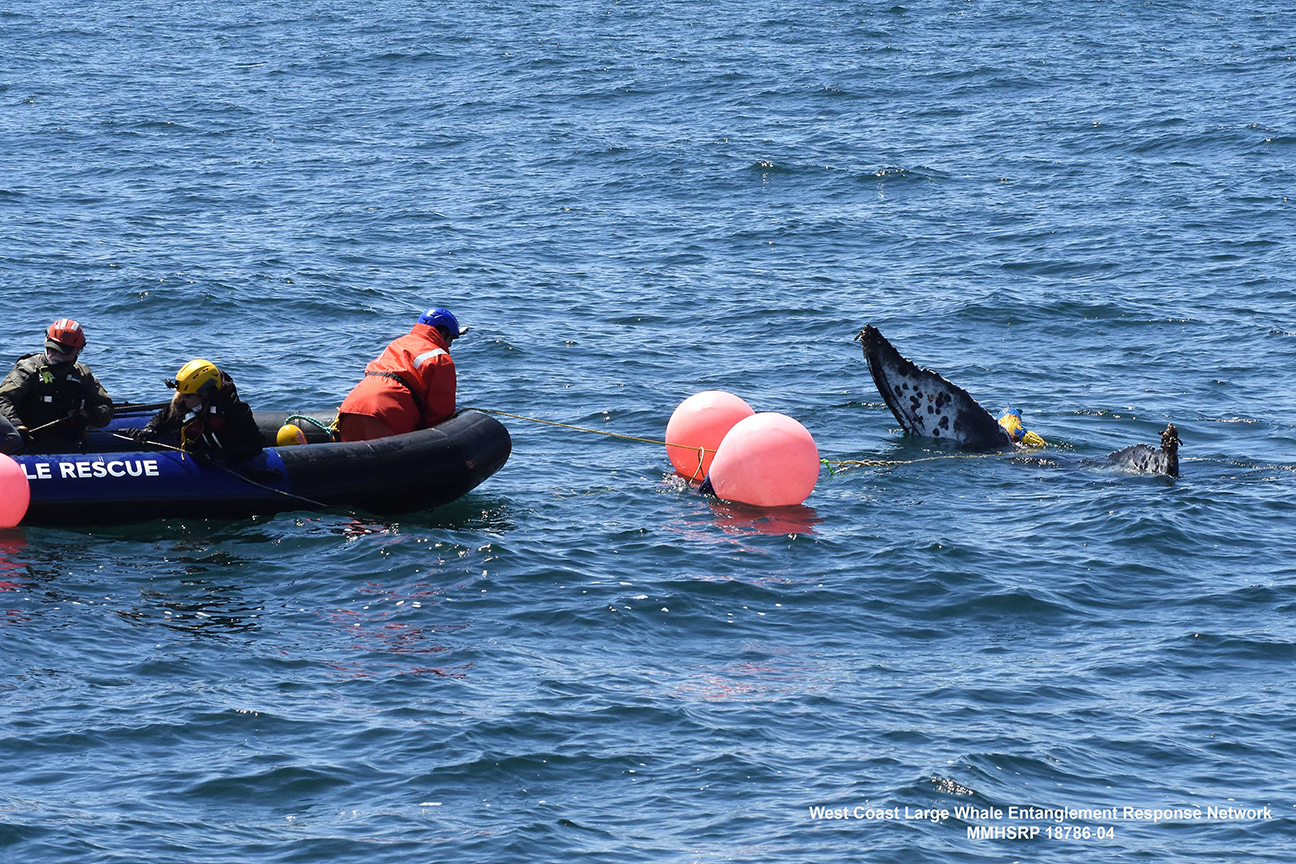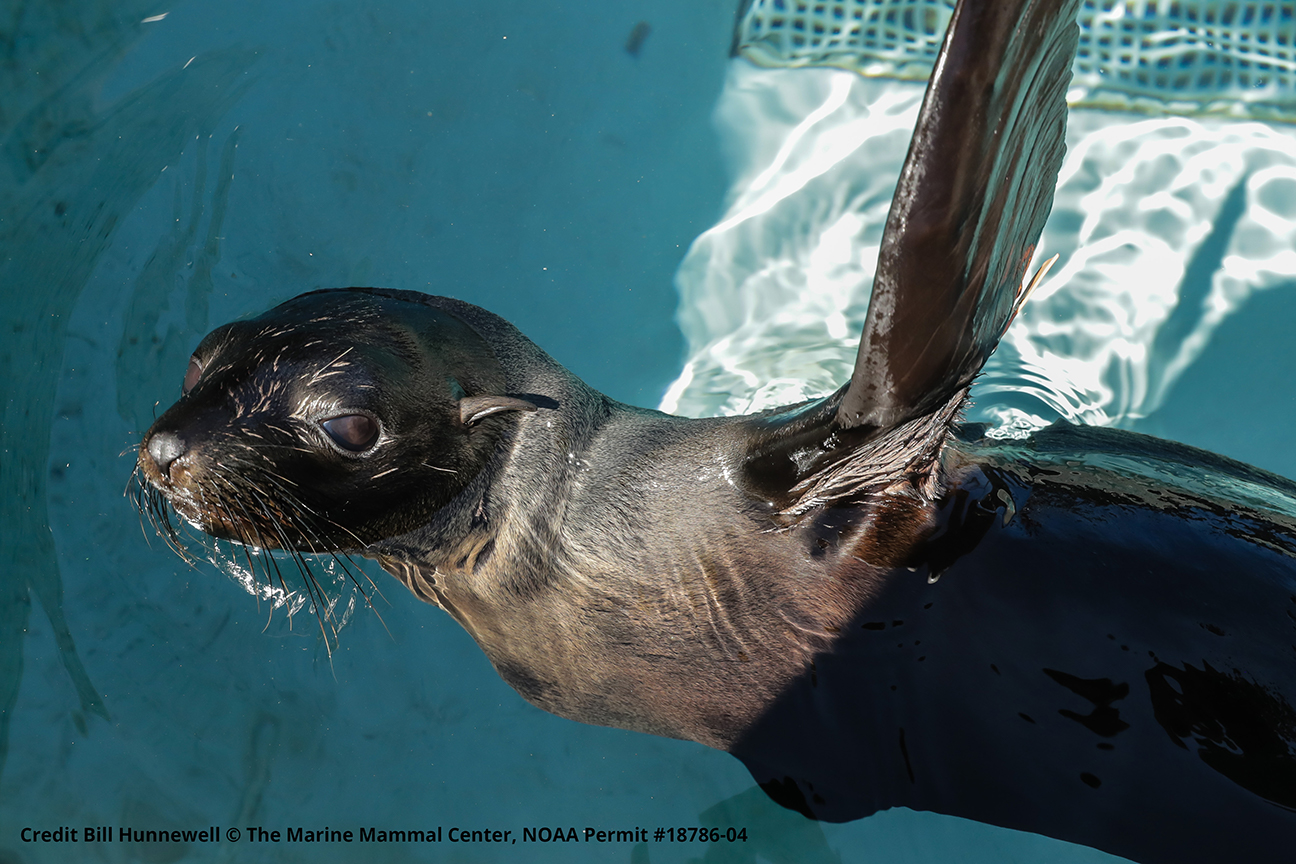Trained responders from The Marine Mammal Center’s Monterey Bay Operations prepare to attempt a boat rescue of an injured California sea lion at the Monterey Coast Guard Pier in Monterey, CA. To learn more about the Center and how to support the recovery of patients suffering from entanglements, text OCEAN to 41444 to donate or visit MarineMammalCenter.org/donate. Credit © The Marine Mammal Center
Related Coverage: To the Ice and Back Travels and travails of Antarctic researchers during pandemic
| FEATURED
By Kyle Martin
As Central Coast residents mitigate the threat of COVID-19, a cadre of local scientists working on marine mammal research has been undeterred in their quest. And the U.S. government has taken a liking to their efforts to find out more.
But COVID has shuttered a lot of research possibilities as well as the labs in which those scientists need to do their work. Since the start of the pandemic, research opportunities on the waters of the Monterey Bay Marine Sanctuary and elsewhere have been changed, rescheduled or shut down.
In efforts to keep its volunteers and staff safe from COVID infection, the Marine Mammal Center has stopped many of their rescue missions to save animals in and around Monterey Bay.
Even so, there are a few new unique scientific research opportunities that have opened up now that humankind’s influence on the world has been muted.
Enlarge

COVID strikes
On April 27, Dr. Ari Friedlaender and Dr. Caroline Casey, a married couple of marine scientists with extensive research backgrounds, along with Julia O’Hern, manager of the Marine Mammal Center in Moss Landing, were able to find a way out onto the sea as they navigated the precautions that come along with COVID.
Local COVID orders have closed off much of the usual water access, and many boats haven’t been able to set sail, resulting in fewer marine researchers actually being able to get to where they need to go to do research.
“Everything sort of got put on hold, in terms of being able to go out on the water and do work out there,” Casey said. “Once lockdown hit, basically all field work was halted for almost everybody.”
It’s also been problematic for marine mammal rescue. O’Hern said sea lions pups get stranded in significantly high numbers during the summer and this is typically the Marine Mammal Center’s busiest time of year.
“It’s a little nerve-wracking to sort of come up with a new plan and adapt old plans very quickly,” O’Hern said. “It’s a unique human health crisis in the sense that we typically deal with animal health crises.
“I guess we were fortunate in the sense that having this kind of preparedness for unique and challenging situations is something that we have to do, and that we train folks to do. But of course, something like what we’re going through right now is definitely not anything that I had on my radar.”
In May, a joint rescue effort between the Marine Mammal Center and the U.S. Coast Guard saved a humpback whale tangled in crab fishing gear in Monterey Bay, but plenty of other calls about lost or stranded animals have gone unchecked because of pandemic restrictions.
“In the very beginning, the biggest decision we had to make was, ‘Were we essential?’” said Dr. Shawn Johnson, vice president of veterinary medicine and science at the Marine Mammal Center. “We clearly felt that rescuing animals was a public service that we were providing. And we’re a veterinary hospital, which is an essential service.”
Johnson said they decided as veterinarians operating a veterinary hospital, yes, they were essential. But as marine animal rescuers and researchers, not necessarily. Not all the time. Not if it was ultimately more dangerous to humanity by threat of COVID outbreak.
“It’s hindered our ability to mount rescue responses to the beaches and get access to the beaches and, to be honest, a lot of our volunteers aren’t comfortable going out into the public and being surrounded by a bunch of people on the beach who may not be socially distancing and wearing a mask,” Johnson said.
While the Marine Mammal Center is normally equipped with plenty of personal protective equipment, sanitizer, masks and other medical materials for its veterinary staff, many closed-quarters rescue missions just couldn’t happen.
But meanwhile, Friedlaender came up with some plans for the future and asked Johnson, O’Hern, Casey and other scientists around Monterey for help. Together, they began sampling blubber in humpback whales in Monterey Bay.
Enlarge

A new idea
“We need to go out and do this,” Friedlaender said, recalling a conversation he had early on about taking samples from Monterey Bay whales. “I don’t care if we don’t have money, we just need to do it.”
Friedlaender and Casey connected with O’Hern and the Marine Mammal Center to get a small vessel on the water — socially distanced, of course. Armed with a crossbow-like device to collect blubber samples from the giant marine mammals, the group spent five days collecting dozens of samples, which are now stored and ready to be analyzed.
They’re trying to determine whether humpback whales coming through the bay have higher cortisol levels — a stress hormone — during periods of high human noise and boat traffic, versus right now without as much noise and traffic.
Or, more simply, if whales are more stressed because of us.
“This is important for a lot of reasons,” Friedlaender said. “The fact that humans influence almost every environment and every ecosystem on the planet and we are all over the place. And we are polluting with noise, we’re polluting with chemicals, we’re polluting in all sorts of ways and extracting and changing systems. And we very rarely have an opportunity to think about, let alone quantify, what impact we’re having on these systems.”
Casey said that unlike other creatures stressed by their environment, whales have fewer options to move away from the source of their distress. Their favorite feeding grounds are in the Monterey Bay Marine Sanctuary, so in order to get food, they have to come here and endure human commotion.
“Amazingly, if you leave them alone, they have the opportunity to rebound,” Casey said. “We want to keep that happening.”
“Whales are a really great representative for, not only the health and wellness of the marine ecosystems, but they also are the sentinels for being able to tell us how much stress we as humans are putting on the environment,” Friedlaender said. “And so, with all the bad things that this pandemic has done to affect humans, it’s relieved some pressures on animals and ecosystems in ways that are likely to give them a little bit of a breath — some breathing room.”
It wasn’t all that long ago that whale populations were traumatized and decimated by whaling along the Pacific Coast and elsewhere. Even just two years ago, California recorded the highest number of whale deaths by ship collision since the 1980s, according to the Washington Post, after a humpback was killed by a freight container ship coming into San Francisco.
Enlarge

The Way Forward
Immediately after their April sampling, Friedlaender said he pitched the National Science Foundation on a grant to fund the project. He got notice at the end of June the NSF is planning to take them up on their research and award them more than $100,000 this month to continue their studies.
This will pay for researchers to analyze data, another ship and crew to go out and sample whales again during the same time period next year, and plenty of other gear and logistics costs. This includes help from the Monterey Bay Aquarium Research Institute (MBARI), which has gear such as hydrophones, and expertise to gather and analyze acoustic samples in the water to show human and boat noise reduction throughout the ocean.
In partnership with the Marine Mammal Center, the University of California, Santa Cruz, MBARI and the California Ocean Alliance, a new team of marine researchers and ocean stewards hoping to take on major exploits into the world’s waters, there will be new, real-time data proving the impact of human activity on whale populations.
Have something to say about this story? Send us a letter.